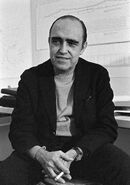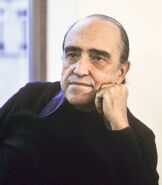No edit summary Tag: Visual edit |
No edit summary Tag: Visual edit |
||
| (One intermediate revision by one other user not shown) | |||
| Line 1: | Line 1: | ||
| + | {{Infobox centenarian |
||
| + | |Oscar Niemeyer |
||
| + | |image = Oscar Niemeyer.jpg |image size = 286 |
||
| + | |caption = Niemeyer's last photo |
||
| + | |sex = Male |
||
| + | |status = deceased-centenarian |
||
| + | |nationality = Brazilian |
||
| + | |birthyr = 1907 |birthplace = Rio de Janeiro City, Rio de Janeiro State, Brazil |
||
| + | |deathyr = 2012 |deathplace = Rio de Janeiro City, Rio de Janeiro State, Brazil |
||
| + | |sort = Niemeyer, Oscar |
||
| + | }}<!-- |
||
| + | -->'''Oscar Ribeiro de Almeida Niemeyer Soares Filho''' (15 December 1907 – 5 December 2012), known as '''Oscar Niemeyer''', was a Brazilian [[centenarian]] and architect considered to be one of the key figures in the development of modern architecture. Niemeyer was best known for his design of civic buildings for Brasilia, a planned city that became Brazil's capital in 1960, as well as his collaboration with other architects on the headquarters of the United Nations in New York. His exploration of the aesthetic possibilities of reinforced concrete was highly influential in the late 20th and early 21st centuries. |
||
| + | Both lauded and criticized for being a "sculptor of monuments", Niemeyer was hailed as a great artist and one of the greatest architects of his generation by his supporters. He said his architecture was strongly influenced by [[Wikipedia:Le Corbusier|Le Corbusier]], but in an interview, assured that this "didn't prevent [his] architecture from going in a different direction". Niemeyer was most famous for his use of abstract forms. |
||
| − | '''Oscar Niemeyer''' (15 December 1907 - 5 December 2012) Was a [[Centenarian]] from [[List of Brazilian supercentenarians|Brazil]]. |
||
| − | == |
+ | ==Biography== |
| + | Niemeyer was born in Rio de Janeiro City, Rio de Janeiro State, Brazil on 15 December 1907. His parents were Oscar de Niemeyer Soares and Delphina Ribeiro de Almeida. His great-grandfather was a Portuguese immigrant who, in turn, was the grandson of a German soldier who had settled in Portugal. |
||
| − | Oscar Niemeyer Born In 1907, Oscar Niemeyer Was A Master Of Architecture, And He Also Participated In The Construction Of The Architectures Of Brasília, Capital Of Brazil, And He Won Several Awards, As Lenin da Paz Award (1963), Pritzker Architecture Award (1988) , Príncipe da Asturias Award (1989), Chico Mendes Medal (1989), RIBA Gold Medal (1998), Praemium Imperiale (2004) And graduated at the University of School of Fine Arts - UFRJ. |
||
| + | Niemeyer was educated at the Escola Nacional de Belas Artes at the Federal University of Rio de Janeiro, and after graduating, he worked at his father's typography house and as a draftsman for local architectural firms. In the 1930s, he interned with [[Wikipedia:Lúcio Costa|Lucio Costa]], with the pair collaborating on the design for the Palacio Gustavo Capanema in Rio de Janeiro. Niemeyer's first major project was a series of buildings for Pampulha, a planned suburb north of Belo Horizonte. His work, especially on the Church of Saint Francis of Assisi, received critical acclaim and drew international attention. Throughout the 1940s and 1950s, Niemeyer became one of Brazil's most prolific architects, working both domestically and overseas. This included the design of the Edificio Copan (a large residential building in Sao Paulo) and a collaboration with Le Corbusier (and others) on the United Nations Headquarters, which yielded invitations to teach at Yale University and the Harvard Graduate School of Design. |
||
| − | And Respiratory infection was the cause of death for the centenary genius, as reported by the medical team who have assisted him. The architect was accompanied in the night by his wife Vera and his nephew Cadu. |
||
| + | In 1956, Niemeyer was invited by Brazil's new president, [[Wikipedia:Juscelino Kubitschek|Juscelino Kubitschek]], to design the civic buildings for Brazil's new capital, which was to be built in the centre of the country, far from any existing cities. His designs for the National Congress of Brazil, the Cathedral of Brasilia, the Palacio da Alvorada, the Palacio do Planalto, and the Supreme Federal Court, all designed by 1960, were experimental and linked by common design elements. This work led to his appointment as inaugural head of architecture at the University of Brasilia, as well as honorary membership of the American Institute of Architects. Due to his largely left-wing ideology, and involvement with the Brazilian Communist Party (PCB), Niemeyer left the country after the 1964 military coup and opened an office in Paris. He returned to Brazil in 1985, and was awarded the prestigious Pritzker Architecture Prize in 1988. A socialist and atheist from an early age, Niemeyer had spent time in both Cuba and the Soviet Union during his exile, and on his return served as the PCB's president from 1992 to 1996. Niemeyer continued working at the end of the 20th and early 21st century, notably designing the Niteroi Contemporary Art Museum (1996) and the Oscar Niemeyer Museum (2002). Over a career of 78 years he designed approximately 600 projects. |
||
| ⚫ | |||
| − | [[File:Oscar Niemeyer.jpg|alt=Oscar Niemeyer's last photo|left|thumb|Oscar Niemeyer's last photo]] |
||
| + | ===Personal life=== |
||
| + | Niemeyer married Annita Baldo in 1928. They had one daughter, [https://pt.wikipedia.org/wiki/Anna_Maria_Niemeyer Anna Maria], in 1929 (she predeceased her father on 6 June 2012). Niemeyer subsequently had five grandchildren, 13 great-grandchildren and seven great-great-grandchildren. Annita died in 2004 at the age of 93, after 76 years of marriage. In 2006, shortly before his 99th birthday, Niemeyer married for the second time, to his longtime secretary, Vera Lucia Cabreira at his apartment, a month after he had fractured his hip in a fall. |
||
| + | Niemeyer was a keen smoker of cigars, smoking more in later life. His architectural studio was a smoking zone. |
||
| + | Niemeyer died in Rio de Janeiro City, Rio de Janeiro State, Brazil on 5 December 2012 at the age of 104 years, 356 days. |
||
| ⚫ | |||
| + | <gallery> |
||
| + | ONiemeyer1917.jpg|Niemeyer in 1927 |
||
| + | ONiemeyer1968.jpg|Niemeyer in 1968 |
||
| + | ONiemeyer1977.jpg|Niemeyer in 1977 |
||
| + | ONiemeyer100.jpg|Niemeyer receiving the Obelisco FI on his 100th anniversary in 2007 |
||
| + | ONiemeyer2008.jpg|Niemeyer, responsible for the project, during the opening ceremony of the Biblioteca Nacional de Brasilia on 11 December 2008 |
||
| + | ONiemeyerANiemeyer.jpg|Niemeyer with his daughter [https://pt.wikipedia.org/wiki/Anna_Maria_Niemeyer Anna Maria Niemeyer] |
||
| + | </gallery> |
||
| ⚫ | |||
| − | <br /> |
||
| + | *[https://www.geni.com/people/Oscar-Niemeyer/6000000015173393282 Oscar Niemeyer] Geni |
||
| + | *[https://www.architectsjournal.co.uk/news/niemeyer-finds-love-at-98-with-marriage-to-60-year-old-secretary Niemeyer finds love at 98 with marriage to 60-year-old secretary] The Architects' Journal, 20 November 2006 |
||
| + | *[https://web.archive.org/web/20110102100257/http://www.azuremagazine.com/newsviews/blog_content.php?id=728 Niemeyer's Century] Azure, 8 December 2007 <sup>(Archived)</sup> |
||
| + | *[https://web.archive.org/web/20090228051940/http://literal.terra.com.br/literal/calandra.nsf/0/00F797984C445FC9032573A800018D75?OpenDocument&pub=T&proj=Literal&sec=Resmungos Ferreira Gullar - Resmungos] Portal Literal, 28 February 2009 <sup>(Archived)</sup> |
||
| + | *[https://www.independent.co.uk/arts-entertainment/architecture/swerve-verve-oscar-niemeyer-architect-who-eradicated-straight-line-1944761.html Swerve with verve: Oscar Niemeyer, the architect who eradicated the straight line] The Independent, 23 October 2011 |
||
| + | *[https://www1.folha.uol.com.br/cotidiano/1101462-anna-maria-niemeyer-1929-2012---galerista-e-parceira-do-pai-oscar.shtml Anna Maria Niemeyer (1929-2012) - Galerista e parceira do pai, Oscar] Folha de S.Paulo, 7 June 2012 |
||
| ⚫ | |||
| + | *[https://www.theguardian.com/artanddesign/architecture-design-blog/2012/dec/07/oscar-niemeyer-tributes-architects-critics?INTCMP=SRCH Oscar Niemeyer: architects and critics pay tribute] The Guardian, 7 December 2012 |
||
| − | |||
| − | |||
| − | <br /> |
||
| − | |||
| ⚫ | |||
| − | |||
| − | * http://bancax.org.br/2012/12/06/post18680/ |
||
| − | * https://simple.wikipedia.org/wiki/Oscar_Niemeyer |
||
| − | * https://pt.wikipedia.org/wiki/Oscar_Niemeyer#Outras_artes |
||
| − | * https://www.nytimes.com/2012/12/06/world/americas/oscar-niemeyer-modernist-architect-of-brasilia-dies-at-104.html |
||
| − | * https://br.pinterest.com/pin/574560864961995298/ |
||
| ⚫ | |||
| − | * https://www.designboom.com/architecture/oscar-niemeyer-dies-at-104/ |
||
| − | * https://br.pinterest.com/pin/102316222755892239/ |
||
| − | * https://www.archdaily.com/303374/oscar-niemeyer-brazils-modernist-icon-dies |
||
| − | * https://www.dw.com/en/master-of-the-curve-oscar-niemeyer-dies/a-16431498 |
||
| − | * https://www1.folha.uol.com.br/internacional/en/culture/2012/12/1196788-architect-oscar-niemeyer-dies-at-age-104-in-rio.shtml |
||
| − | |||
| ⚫ | |||
[[Category:1907 births]] |
[[Category:1907 births]] |
||
[[Category:2012 deaths]] |
[[Category:2012 deaths]] |
||
| + | [[Category:Rio de Janeiro births]] |
||
[[Category:Brazil births]] |
[[Category:Brazil births]] |
||
[[Category:Brazilian centenarians]] |
[[Category:Brazilian centenarians]] |
||
[[Category:Male centenarians]] |
[[Category:Male centenarians]] |
||
| − | [[Category: |
+ | [[Category:Rio de Janeiro deaths]] |
[[Category:Brazil deaths]] |
[[Category:Brazil deaths]] |
||
[[Category:Centenarians notable for other reasons than longevity]] |
[[Category:Centenarians notable for other reasons than longevity]] |
||
| ⚫ | |||
Latest revision as of 02:35, 7 December 2021
| Oscar Niemeyer | |
 Niemeyer's last photo | |
| Birth: | 15 December 1907 Rio de Janeiro City, Rio de Janeiro State, Brazil |
| Death: | 5 December 2012 Rio de Janeiro City, Rio de Janeiro State, Brazil |
| Age: | 104 years, 356 days |
| Country: | |
| Centenarian | |
Oscar Ribeiro de Almeida Niemeyer Soares Filho (15 December 1907 – 5 December 2012), known as Oscar Niemeyer, was a Brazilian centenarian and architect considered to be one of the key figures in the development of modern architecture. Niemeyer was best known for his design of civic buildings for Brasilia, a planned city that became Brazil's capital in 1960, as well as his collaboration with other architects on the headquarters of the United Nations in New York. His exploration of the aesthetic possibilities of reinforced concrete was highly influential in the late 20th and early 21st centuries.
Both lauded and criticized for being a "sculptor of monuments", Niemeyer was hailed as a great artist and one of the greatest architects of his generation by his supporters. He said his architecture was strongly influenced by Le Corbusier, but in an interview, assured that this "didn't prevent [his] architecture from going in a different direction". Niemeyer was most famous for his use of abstract forms.
Biography
Niemeyer was born in Rio de Janeiro City, Rio de Janeiro State, Brazil on 15 December 1907. His parents were Oscar de Niemeyer Soares and Delphina Ribeiro de Almeida. His great-grandfather was a Portuguese immigrant who, in turn, was the grandson of a German soldier who had settled in Portugal.
Niemeyer was educated at the Escola Nacional de Belas Artes at the Federal University of Rio de Janeiro, and after graduating, he worked at his father's typography house and as a draftsman for local architectural firms. In the 1930s, he interned with Lucio Costa, with the pair collaborating on the design for the Palacio Gustavo Capanema in Rio de Janeiro. Niemeyer's first major project was a series of buildings for Pampulha, a planned suburb north of Belo Horizonte. His work, especially on the Church of Saint Francis of Assisi, received critical acclaim and drew international attention. Throughout the 1940s and 1950s, Niemeyer became one of Brazil's most prolific architects, working both domestically and overseas. This included the design of the Edificio Copan (a large residential building in Sao Paulo) and a collaboration with Le Corbusier (and others) on the United Nations Headquarters, which yielded invitations to teach at Yale University and the Harvard Graduate School of Design.
In 1956, Niemeyer was invited by Brazil's new president, Juscelino Kubitschek, to design the civic buildings for Brazil's new capital, which was to be built in the centre of the country, far from any existing cities. His designs for the National Congress of Brazil, the Cathedral of Brasilia, the Palacio da Alvorada, the Palacio do Planalto, and the Supreme Federal Court, all designed by 1960, were experimental and linked by common design elements. This work led to his appointment as inaugural head of architecture at the University of Brasilia, as well as honorary membership of the American Institute of Architects. Due to his largely left-wing ideology, and involvement with the Brazilian Communist Party (PCB), Niemeyer left the country after the 1964 military coup and opened an office in Paris. He returned to Brazil in 1985, and was awarded the prestigious Pritzker Architecture Prize in 1988. A socialist and atheist from an early age, Niemeyer had spent time in both Cuba and the Soviet Union during his exile, and on his return served as the PCB's president from 1992 to 1996. Niemeyer continued working at the end of the 20th and early 21st century, notably designing the Niteroi Contemporary Art Museum (1996) and the Oscar Niemeyer Museum (2002). Over a career of 78 years he designed approximately 600 projects.
Personal life
Niemeyer married Annita Baldo in 1928. They had one daughter, Anna Maria, in 1929 (she predeceased her father on 6 June 2012). Niemeyer subsequently had five grandchildren, 13 great-grandchildren and seven great-great-grandchildren. Annita died in 2004 at the age of 93, after 76 years of marriage. In 2006, shortly before his 99th birthday, Niemeyer married for the second time, to his longtime secretary, Vera Lucia Cabreira at his apartment, a month after he had fractured his hip in a fall.
Niemeyer was a keen smoker of cigars, smoking more in later life. His architectural studio was a smoking zone.
Niemeyer died in Rio de Janeiro City, Rio de Janeiro State, Brazil on 5 December 2012 at the age of 104 years, 356 days.
Gallery
References
- Oscar Niemeyer Geni
- Niemeyer finds love at 98 with marriage to 60-year-old secretary The Architects' Journal, 20 November 2006
- Niemeyer's Century Azure, 8 December 2007 (Archived)
- Ferreira Gullar - Resmungos Portal Literal, 28 February 2009 (Archived)
- Swerve with verve: Oscar Niemeyer, the architect who eradicated the straight line The Independent, 23 October 2011
- Anna Maria Niemeyer (1929-2012) - Galerista e parceira do pai, Oscar Folha de S.Paulo, 7 June 2012
- Oscar Niemeyer obituary The Guardian, 6 December 2012
- Oscar Niemeyer: architects and critics pay tribute The Guardian, 7 December 2012






